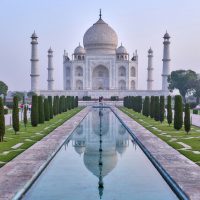Introduction to India’s Popularity
India’s popularity on the global stage can be attributed to a multitude of factors that collectively contribute to its allure. This vast subcontinent, with its rich historical tapestry, offers an array of cultural experiences that resonate with people around the world. The sustained interest in India spans various dimensions, including its traditions, art, cuisine, and spirituality, each drawing tourists and scholars alike, who seek to understand its unique characteristics.
The historical significance of India is a compelling aspect of its appeal. As one of the world’s oldest civilizations, India boasts a legacy that dates back thousands of years. From the ancient Indus Valley civilization to the empires that contributed to its vast and varied heritage, the stories embedded in its monuments and archaeological sites capture the curiosity of historians and travelers. This historical profundity invites a deeper investigation into the social, political, and philosophical evolutions that have shaped modern India.
Moreover, India’s cultural diversity plays a significant role in fostering global interest. With 22 officially recognized languages and hundreds of distinct dialects, the subcontinent is a melting pot of ethnic groups and religions. Festivals celebrated throughout the year, such as Diwali and Holi, not only highlight the vibrancy of Indian life but also attract tourism and cultural exchange. As people engage with India’s diverse traditions, they discover a semblance of connection and understanding that transcends geographical boundaries.
Another critical element of India’s rising popularity is its dynamic economic growth. As one of the world’s largest economies, India presents numerous opportunities across sectors, including technology, healthcare, and education. This rapid development has garnered international interest and investment, further establishing India’s prominence on the world stage. The convergence of rich cultural heritage and economic potential creates a multifaceted appeal, making India a focal point for global engagement and exploration.
Cultural Diversity and Heritage
India stands out globally for its unparalleled cultural diversity and rich heritage, which significantly contribute to its appeal. The country is home to a multitude of languages, religions, and cultural practices, each enriching the societal fabric and facilitating a unique experience for both its residents and visitors. With more than 1,600 languages spoken, India is one of the most linguistically diverse nations in the world. This linguistic variety fosters a strong sense of identity among various communities and enhances social interactions, thereby attracting scholars and tourists curious about the depth of its cultural landscape.
Religiously, India is a melting pot of beliefs, accommodating Hinduism, Buddhism, Jainism, Sikhism, Islam, Christianity, and numerous other traditions. This plethora of religions not only influences daily life but also shapes festivals and cultural observances, which are celebrated with immense zeal throughout the year. From Diwali, the Festival of Lights, to Eid, Christmas, and Pongal, these celebrations showcase the vivid tapestry of Indian life and ethics, promoting a spirit of unity in diversity.
Moreover, India’s rich heritage sites such as the Taj Mahal, Jaipur’s forts, and the ancient cities of Varanasi and Haridwar further amplify its attraction on a global scale. Architectural masterpieces and historical landmarks narrate stories of India’s glorious past, drawing historians, artists, and tourists who seek to explore its profound legacy. Cultural practices like yoga and Ayurveda have also gained international recognition, highlighting India’s contributions to holistic wellness and spirituality.
The interplay of these diverse cultures promotes a continuous exchange of ideas and inspirations, enhancing India’s global reputation as a vibrant and captivating nation. Thus, the cultural diversity and heritage of India are not merely aspects of its identity; they are crucial elements that foster global curiosity and admiration.
Economic Growth and Development
The remarkable economic growth of India in recent decades has positioned it as one of the largest economies worldwide, catching the attention of global investors and business leaders alike. A combination of strategic reforms, a young and dynamic workforce, and an expanding middle class has fueled this rapid development. The technology sector, in particular, has played a pivotal role, with India emerging as a hub for IT services and software development. Companies like Tata Consultancy Services and Infosys have not only established a strong domestic presence but have also gained international recognition, contributing significantly to the country’s GDP.
Furthermore, agriculture continues to be a cornerstone of the Indian economy, employing a substantial portion of the population. Modernization initiatives and the adoption of innovative practices have led to enhanced productivity and sustainability in this sector. The government’s focus on improving infrastructure and logistics further supports agricultural growth, enabling better market access for farmers and increasing food security. This overall transformation in agriculture is attracting attention from agro-based industries both domestically and internationally.
The manufacturing sector is also witnessing impressive growth, bolstered by initiatives such as “Make in India,” which aims to encourage domestic and foreign companies to manufacture their products in India. This initiative has led to a surge in foreign direct investment (FDI), particularly in sectors like textiles, automotive, and electronics. The favorable demographic dividend, with a significant portion of the population being young and eager to work, further enhances the appeal of India as a destination for manufacturing operations.
These sectors collectively create a conducive environment for foreign investment and skilled talent, reinforcing India’s global economic appeal. By capitalizing on its diverse resources and workforce, India continues to develop as an economic powerhouse, fostering greater international collaboration and interest.
Tourism and Natural Attractions
India is renowned for its diverse and breathtaking natural landscapes, which play a critical role in attracting millions of tourists each year. From the towering peaks of the Himalayas to the sun-kissed beaches of Goa, India offers an array of natural wonders that cater to different tastes and preferences. The Himalayas, with their majestic snow-capped mountains and serene landscapes, serve as a haven for adventurers, trekkers, and mountaineers. Encapsulating spiritual significance, the region is dotted with holy shrines, providing opportunities for both adventure and introspection.
In contrast, the tropical beaches of places like Andaman and Nicobar Islands or Kerala captivate tourists with their azure waters and unspoiled beauty. Travelers often find solace in the exotic locales, enjoying activities such as snorkeling, diving, and relaxing on sandy shores. This combination of high-altitude adventures and coastal relaxation exemplifies the rich biodiversity and geological diversity found throughout the country.
The appeal of India does not solely lie in its natural attractions; historical sites such as the iconic Taj Mahal also enhance its allure. Recognized as one of the Seven Wonders of the World, the Taj Mahal symbolizes love and architectural brilliance. Visitors flock to this marvel to experience the intricate artistry and historical significance that it embodies. Furthermore, India’s national parks, such as Jim Corbett and Ranthambore, provide opportunities for wildlife enthusiasts to witness the country’s rich fauna, including the majestic Bengal tiger in its natural habitat.
Overall, India’s blend of striking natural landscapes and historically rich attractions makes it a sought-after travel destination. As tourists seek both adventure and cultural experiences, the multitude of attractions facilitates the nation’s popularity on the global stage. The diverse offerings not only create memorable journeys for travelers but also promote a deeper appreciation for the country’s heritage and environmental richness.
Spiritual and Philosophical Appeal
India is often regarded as a global epicenter for spirituality and philosophy, drawing individuals from around the world who seek deeper understanding and enlightenment. This distinction arises not only from its ancient traditions but also from its status as the birthplace of several major religions, including Hinduism, Buddhism, Jainism, and Sikhism. Each of these faiths offers unique philosophical insights that resonate with diverse audiences, catering to the universal quest for meaning and purpose.
The profound impact of India’s spiritual landscape is manifested in various practices such as yoga and meditation, which have gained considerable traction globally. Yoga, originating from ancient Hindu texts, is not merely a physical exercise but a holistic approach to achieving balance in life, merging the body, mind, and spirit. Similarly, meditation practices rooted in Buddhist traditions emphasize mindfulness and self-awareness, promoting mental clarity and emotional resilience. These techniques have proven beneficial in addressing modern-day stresses, increasing their appeal among those pursuing wellness and personal growth.
Moreover, India is home to numerous ashrams and wellness retreats, attracting spiritual seekers and wellness enthusiasts alike. These facilities offer immersive experiences that allow individuals to disconnect from their daily lives and engage in introspective practices. Visitors often participate in workshops, retreats, and spiritual ceremonies that nurture their inner growth. The serene landscapes, rich cultural heritage, and the intrinsic spirituality of India contribute significantly to its allure.
As a result, India’s reputation as a spiritual hub continues to flourish, positioning the country as a destination for those seeking mental wellness and enlightenment. The perspective that spirituality can substantially enhance an individual’s quality of life aligns with contemporary global trends, fostering an increased interest in India’s rich spiritual heritage. Consequently, this spiritual and philosophical appeal plays a vital role in elevating India’s popularity on the global stage.
Bollywood and Popular Culture
Bollywood, the heart of the Indian film industry, has played a significant role in shaping India’s global appeal. Known for its extravagant productions, vibrant storytelling, and memorable music, Bollywood films capture the essence of Indian culture while resonating with audiences around the world. The distinctive blend of drama, romance, and action in these films has transcended geographical boundaries, finding a place in the hearts of many international viewers.
The influence of Bollywood is not limited to cinema alone; it extends to various facets of popular culture, including music and fashion. Iconic soundtracks and catchy dance numbers from Indian films have become global sensations, sparking interest in traditional Indian music as well as contemporary fusion genres. This musical outreach has facilitated a cultural dialogue, allowing people from diverse backgrounds to appreciate and engage with Indian aesthetics.
Television dramas, another significant aspect of Indian entertainment, have also garnered immense popularity. Shows that exhibit distinct cultural narratives, family dynamics, and societal issues resonate with audiences far beyond India’s borders. This wide appeal has played a crucial role in promoting an understanding of India’s complexities and traditions, fostering greater cross-cultural engagement.
The rise of streaming platforms has further accelerated the global reach of Indian cinema. With easy accessibility, audiences can now watch a vast array of Bollywood films and Indian web series, immersing themselves in the country’s rich storytelling traditions. This unprecedented exposure cultivates curiosity about India’s lifestyle, customs, and heritage, encouraging viewers to explore and learn more about the nation.
Overall, Bollywood’s influential presence on the global stage has not only entertained millions but has also actively contributed to a growing interest in Indian culture. By bridging cultural gaps, it has established a unique connection between India and international audiences, making India a focal point of intrigue and admiration worldwide.
Education and Studying Abroad
India has increasingly become a favored destination for international students seeking higher education, owing to its diverse educational offerings and reputable institutions. The country boasts a range of universities that excel in various fields, including engineering, technology, medicine, and the liberal arts. Some of these institutions, such as the Indian Institutes of Technology (IITs) and Indian Institutes of Management (IIMs), are renowned globally, attracting students from across the world. This trend reflects a growing recognition of India’s commitment to providing high-quality education and opportunities for research and innovation.
In addition, India’s rich cultural heritage and vibrant student life contribute significantly to its appeal as a study destination. International students often seek not only academic excellence but also an enriching cultural experience. Living in India allows them to immerse themselves in a diverse society, where multiple languages, traditions, and cuisines coexist. Furthermore, students have access to affordable living costs and tuition fees compared to Western countries, making it an economically viable option for many aspiring scholars.
Simultaneously, Indian students are increasingly pursuing their education abroad, motivated by the pursuit of advanced degrees, international exposure, and the desire to develop a global network. This trend is fueled by India’s growing emphasis on higher education and the global recognition of its graduates. Alumni from Indian institutions often secure prominent positions in multinational companies and leading organizations worldwide, enhancing the value of an Indian education on the global stage.
As India continues to evolve as a hub for higher education, both inbound and outbound student mobility reflects a mutual exchange of knowledge, ideas, and cultures, further solidifying India’s reputation as a significant player in the global educational landscape.
The Role of Technology and Innovation
India has emerged as a crucial player in the global technology and innovation landscape, significantly shaping its reputation on the world stage. The country’s burgeoning tech industry is characterized by a dynamic start-up culture and groundbreaking advancements in digital technology. This growth is facilitated by a unique combination of a large, skilled workforce, a youthful demographic, and a strong educational foundation in STEM (Science, Technology, Engineering, and Mathematics) fields.
The Indian tech industry has produced a multitude of successful start-ups that have made notable contributions to various sectors, ranging from e-commerce to fintech and health tech. Companies like Flipkart, Zomato, and Paytm exemplify how Indian entrepreneurs are harnessing innovative solutions to meet local and international demands. The rapid growth of these technology-driven companies has attracted significant foreign investment and has sparked collaboration with global tech giants, thus positioning India at the forefront of innovation.
Moreover, India’s government has initiated several programs aimed at fostering innovation and entrepreneurship. Initiatives such as ‘Make in India’ and ‘Digital India’ highlight the country’s commitment to leveraging technology for economic growth and societal advancement. Such policies are designed to ensure a robust ecosystem for startups, encouraging research and development that can compete on a global scale. Additionally, India’s focus on data science, artificial intelligence, and software development is reshaping industries and creating new opportunities for its workforce.
In essence, the synergy of technology and innovation within India does not merely contribute to economic advancement; it also enhances the country’s global appeal. As India continues to evolve as a technological hub, it is poised to attract more international collaborations, solidifying its status as a nation that is not only keeping pace with global advancements but is also setting trends that impact the future of technology worldwide.
Conclusion: A Vibrant Future Ahead
India’s popularity on the global stage can be attributed to a confluence of cultural richness, economic dynamism, and a growing presence in international discourse. Throughout this exploration, key elements such as its enduring traditions, diverse languages, and ancient practices have showcased the depth of Indian culture, enticing individuals from all walks of life. This cultural appeal is complemented by a burgeoning economy, which is on track to become one of the largest in the world. By embracing modern technologies and fostering a startup ecosystem, India is positioning itself as a leading player in the global market.
The future trajectory of India appears promising, especially with its emphasis on sustainable development and inclusivity. India’s commitment to social reform, environmental sustainability, and innovation sets the foundation for its continued ascent into the global spotlight. As it moves forward, India will likely enhance its global engagement through multilateral partnerships and initiatives that address pressing global issues, such as climate change and poverty alleviation. This willingness to engage with the world suggests that India will not only maintain its place of importance but also expand its influence worldwide.
Moreover, the ongoing cultural exchanges facilitated by the Indian diaspora serve as a bridge, bringing a deeper understanding of Indian customs and values to international audiences. This global interplay fosters a rich dialogue that can shape perceptions and experiences positively. As India evolves, both its citizens and global observers will have the opportunity to reflect on the evolving narrative of this remarkable nation. In concluding this discussion, it is clear that India’s potential is immense, and its future holds boundless possibilities that will undoubtedly captivate audiences around the globe.






